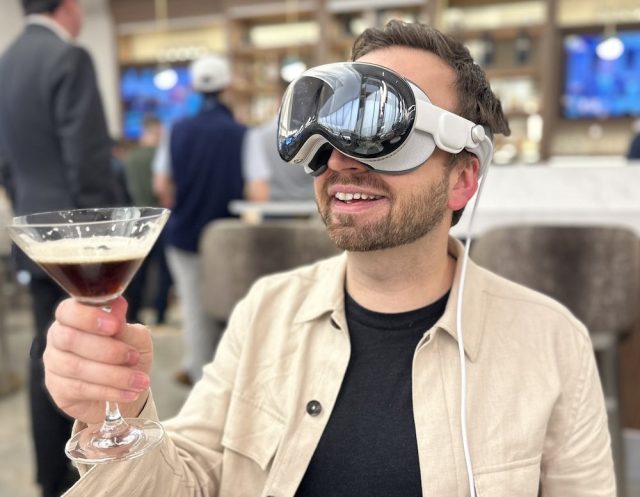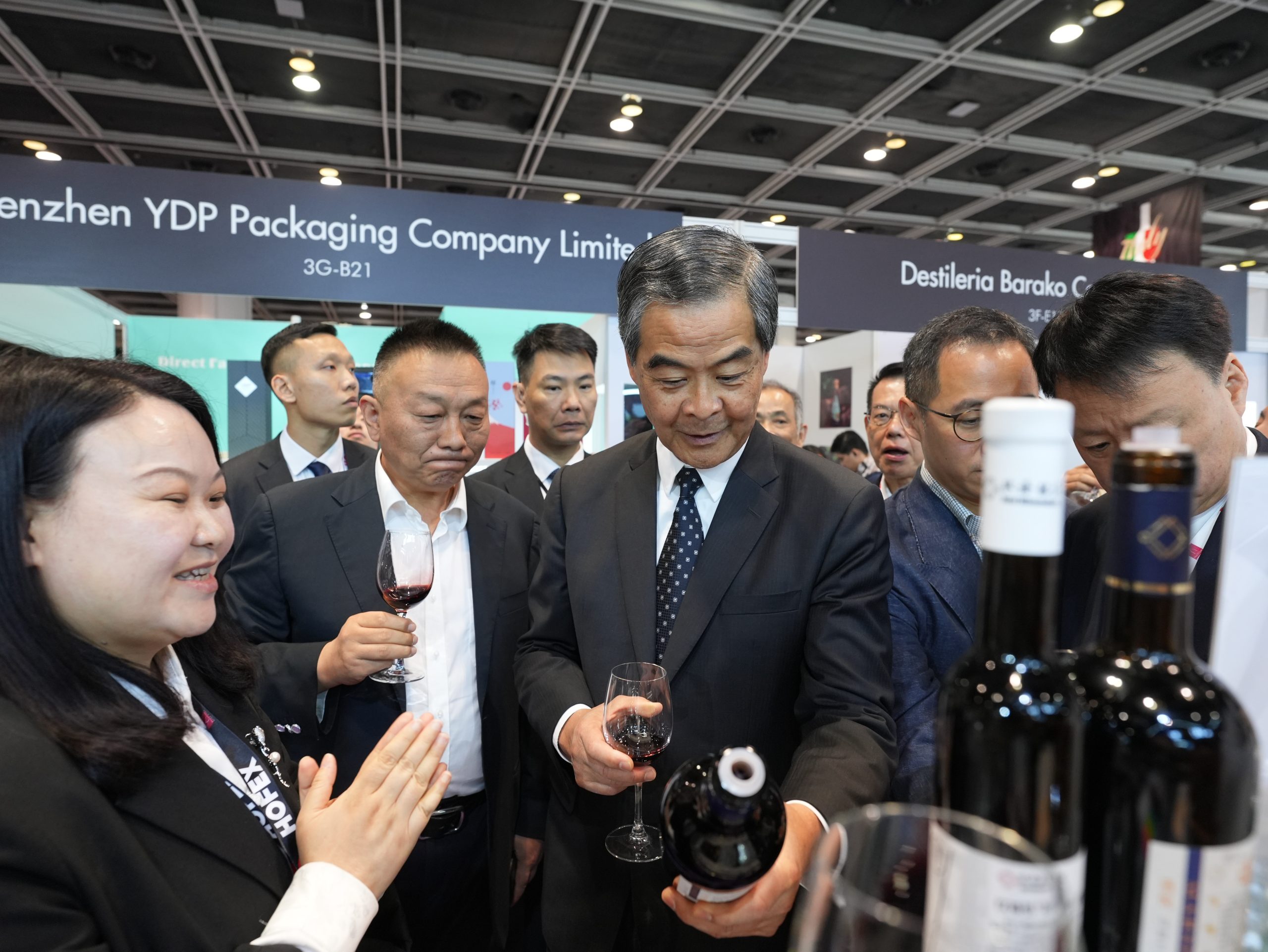Will the Apple Vision Pro change the drinks industry forever?
The future of “spatial computing” began on Friday with the launch in the US of the Apple Vision Pro. But can augmented reality truly change the world, including the drinks industry?

Looking at some of the amusing images on social media of people walking around with Vision Pro goggles on, you would be forgiven for thinking this new device is little more than a niche toy for crypto-bros.
But, as some readers may remember, we also used to find amusing those city workers with briefcase phones in the 1980s. It felt unlikely that technology would ever see mass adoption, and certainly not revolutionise the world. Fast forward a decade to the late 1990s, and that’s exactly what happened.
The Vision Pro is probably a similar device to those early portable phones. Priced at US$3,499 (and with add-ons, even more), this is not a device we will see regularly on the street any time soon.
But the reality is the technology is revolutionary because it shifts the dial on how we view the world, the distance between the virtual and reality, and how we go around our daily life and jobs.
This approach is called augmented reality, or as Apple’s CEO Tim Cook has dubbed it “spatial computing”. It places the digital world into your living room or workplace, filling a ‘real’ world with digital visuals.
Potentially, it could remove televisions, personal computers, the mobile phone, game consoles, projectors and much of the traditional ‘tech’ we have in a domestic and professional space.
And it’s potential impact on the drinks industry is significant. db takes a look at how this new category of technology will impact the drinks trade.
Interactive, immersive tastings
In a similar way to pure virtual reality, the most instant applicaiton for augmented reality is clearest in the realm of drinks education.
Let’s walk through what it could look like…
Firstly, imagine doing a wine tasting with a producer in a different country, and where you don’t speak the language.
The potential for instant translation has already been showcased.
3. Real-Time Captions and Translationpic.twitter.com/sAhQYHvhYM
— Alvaro Cintas (@dr_cintas) February 3, 2024
You would then have the wines in front of you, on a live stream, in a virtual tasting room that replicates the producer’s or distributor’s own facility, with a live translation. You will be sitting in the room with other learners.
Looking at each wine label would bring up the producer’s website with a video of their vineyards and production facilities, perhaps you would be instantly transported to a vineyard on the other side of the world, in Mendoza or Napa or Bordeaux.
A collection of tasting notes would also float in the air, which you could edit and comment on alongside other users. Virtual dishes of food would appear with recipes to show how you could match the wine and food.
This isn’t hyberbole. The type of videos already being produced by Joanna Stern, a tech reporter for the Wall Street Journal, who has been reviewing the device, clearly illustrates how our relationship with food and drink can be altered forever.
Learning detailed new recipes, information about new drinks, will very soon be just one tap away.
You won’t find it in Apple’s marketing but the Vision Pro is the ultimate cooking computer. Was one of the moments where I could really see the future… pic.twitter.com/ph8n0NgUHI
— Joanna Stern (@JoannaStern) January 30, 2024
In the on-trade
The business potential for the drinks trade is also significant. In the on-trade the device could become a wonderful tool for quick stock takes, for example.
Simply look in a fridge, it will scan all the products, see what is nearly out of stock, and reorder it. Scan your eyes across the back-bar and it will tell you when to top up the vodka and whisky based on current sales data.
These are the sort of applications which could become possible with augmented reality.
The bartender let me record him mixing my drink in Spatial Video. It’s in 3D on the Apple Vision Pro headset.
Then I let him try it on. He loved it! “This is so cool. In a pretty good bartender.” I’m telling you, it’s pretty cool to try out. https://t.co/7TqhLX6QTw pic.twitter.com/0g6Ir1aeWd
— Matt Swider (once-a-day tech deals @ The Shortcut) (@mattswider) February 3, 2024
Transparency
Increasingly consumers are looking for more information about their bottles of wine, beer or spirits, and this will now be at everyone’s fingertips.
This includes the environmental footprint of the product, the community and production methods used, and also the health and nutritional information.
Although QR codes and other technology has been available for consumers to scan bottles and discover more about the brand, as well as apps that allow you to take images and find out further information. But Vision Pro takes out the two or three steps currently required, and which are a big barrier.
Consumers will simply walk down a drinks aisle in a supermarket or off-licence and focus on a product, bringing up all of the information, including calories, ABV, where and how it was produced, and its price relative to other retailers.
You will be able to instantly see whether that bottle of Champagne is the best deal, or whether that bottle of red you’ve never tried is a good choice.
Landscapes and agricultural applications
On the production and agricultural side, augmented reality could be used in the vineyard, the winery and the brewery to radical effect.
Vineyard management could include drones and augmented reality to do vine analysis. Imagine also walking among the vines or hop bines with an augmented reality device closely monitoring the condition of the grapes or hops, which the casual human eye might easily miss.
Indeed, it could be combined with previous and forthcoming weather data to provide an analysis of the likelihood of mildew or other unwanted conditions, and what needs to be done to stop the rot.
Equally, once production starts and brewers and winemakers are training staff, augmented reality will be able to take an apprentice through the entire process. A trainee could slowly and steadily be provided instructions on the wort or the must, all the way through to the fermenting vessel and packaging.
These are just some of the immediate and obvious applications of the technology.
If not now, when?
It remains to be seen whether this will be five or ten years or more until the technology lands at everyone’s doorstep.
But just think about that briefcase phone in the 1980s. A decade after that, everyone had a mobile phone. A decade after that everyone had a smartphone. These devices created social media, instant news and information, instant ordering of products from holidays to loo paper which revolutionised delivery, the creation of Uber, Airbnb, and many other companies that would never come into being. Essentially, the whole world as we currently experience it.
Will it be quicker than this? Probably. There are already 600 apps on the Vision Pro. At the time of writing its been reported that Apple is already working on the next version of its operating system for its device. Other manufacturers are already developing their own alternatives to Apple’s system. The level of research and development hasn’t been matched since the early days of the mobile phone. And you can see why: according to research by Digi-Capital, augmented reality could surpass US$70-75bn in revenue by last year alone.
Very soon, we could be seeing the world with fresh (digital) eyes.
Related news
Are consumers ready to embrace AI-powered drinks picks?




